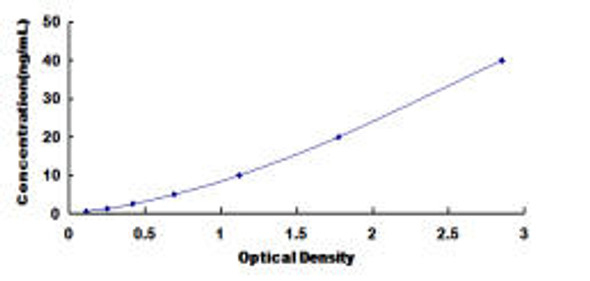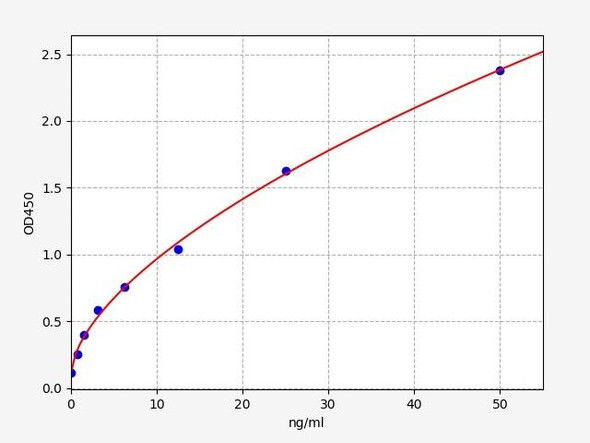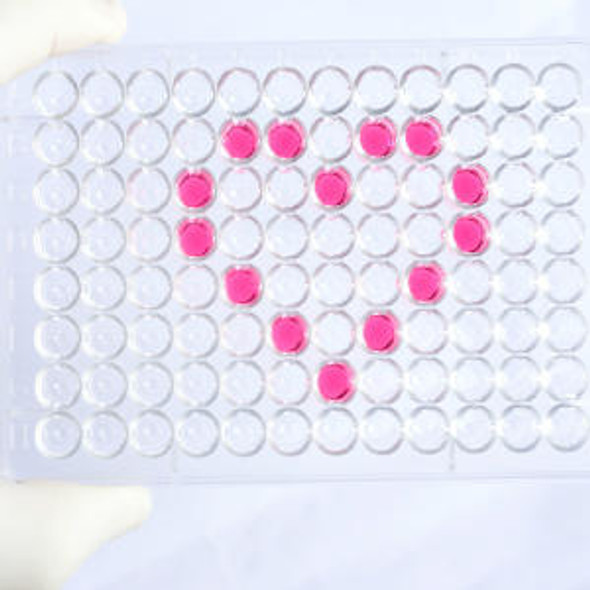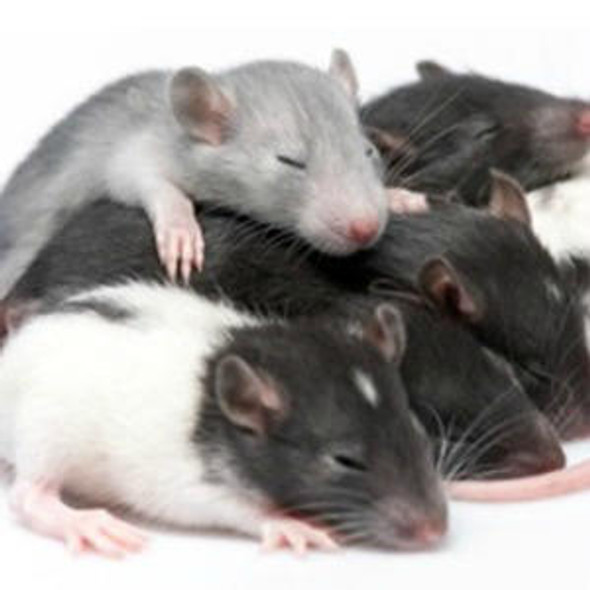Human Cell Death ELISA Kits
Human BAK1 (Bcl2 Antagonist/Killer 1) CLIA Kit (HUES00383)
- SKU:
- HUES00383
- Product Type:
- ELISA Kit
- ELISA Type:
- CLIA Kit
- Size:
- 96 Assays
- Sensitivity:
- 0.09ng/mL
- Range:
- 0.16-10ng/mL
- ELISA Type:
- Sandwich
- Reactivity:
- Human
- Sample Type:
- Serum, plasma and other biological fluids
- Research Area:
- Cell Death
Description
| Assay type: | Sandwich |
| Format: | 96T |
| Assay time: | 4.5h |
| Reactivity: | Human |
| Detection method: | Chemiluminescence |
| Detection range: | 0.16-10 ng/mL |
| Sensitivity: | 0.09 ng/mL |
| Sample volume: | 100µL |
| Sample type: | Serum, plasma and other biological fluids |
| Repeatability: | CV < 15% |
| Specificity: | This kit recognizes Human BAK1 in samples. No significant cross-reactivity or interference between Human BAK1 and analogues was observed. |
This kit uses Sandwich-CLIA as the method. The micro CLIA plate provided in this kit has been pre-coated with an antibody specific to Human BAK1. Standards or samples are added to the appropriate micro CLIA plate wells and combined with the specific antibody. Then a biotinylated detection antibody specific for Human BAK1 and Avidin-Horseradish Peroxidase (HRP) conjugate are added to each micro plate well successively and incubated. Free components are washed away. The substrate solution is added to each well. Only those wells that contain Human BAK1, biotinylated detection antibody and Avidin-HRP conjugate will appear fluorescence. The Relative light unit (RLU) value is measured spectrophotometrically by the Chemiluminescence immunoassay analyzer. The RLU value is positively associated with the concentration of Human BAK1. The concentration of Human BAK1 in the samples can be calculated by comparing the RLU of the samples to the standard curve.
| UniProt Protein Function: | BAK1: In the presence of an appropriate stimulus, accelerates programmed cell death by binding to, and antagonizing the anti- apoptotic action of BCL2 or its adenovirus homolog E1B 19k protein. Low micromolar levels of zinc ions inhibit the promotion of apoptosis. Interacts with BCL2A1. Homodimer. Formation of the homodimer is zinc-dependent. Forms heterodimers with BCL2, E1B 19k protein, and BCL2L1 isoform Bcl-X(L). Interacts with myxoma virus protein M11L. Expressed in a wide variety of tissues, with highest levels in the heart and skeletal muscle. Belongs to the Bcl-2 family. |
| UniProt Protein Details: | Protein type:Membrane protein, integral; Mitochondrial; Endoplasmic reticulum; Apoptosis Chromosomal Location of Human Ortholog: 6p21. 3 Cellular Component: cytosol; endoplasmic reticulum; integral to mitochondrial outer membrane; mitochondrial outer membrane; mitochondrion; pore complex Molecular Function:BH domain binding; chaperone binding; heat shock protein binding; identical protein binding; metal ion binding; protein binding; protein heterodimerization activity; protein homodimerization activity Biological Process: aging; apoptosis; B cell apoptosis; B cell homeostasis; B cell negative selection; blood vessel remodeling; brain development; caspase activation via cytochrome c; cell proliferation; cytolysis; DNA damage response, signal transduction resulting in induction of apoptosis; endocrine pancreas development; endoplasmic reticulum calcium ion homeostasis; establishment and/or maintenance of transmembrane electrochemical gradient; limb morphogenesis; mitochondrial fusion; myeloid cell homeostasis; negative regulation of cell proliferation; negative regulation of peptidyl-serine phosphorylation; organ regeneration; positive regulation of apoptosis; positive regulation of proteolysis; post-embryonic camera-type eye morphogenesis; programmed cell death; reduction of endoplasmic reticulum calcium ion concentration; regulation of cell cycle; regulation of mitochondrial membrane permeability; regulation of mitochondrial membrane potential; regulation of protein heterodimerization activity; regulation of protein homodimerization activity; release of cytochrome c from mitochondria; response to drug; response to ethanol; response to fungus; response to gamma radiation; response to hydrogen peroxide; response to mycotoxin; response to organic cyclic substance; response to UV-C; unfolded protein response, activation of signaling protein activity; vagina development |
| NCBI Summary: | The protein encoded by this gene belongs to the BCL2 protein family. BCL2 family members form oligomers or heterodimers and act as anti- or pro-apoptotic regulators that are involved in a wide variety of cellular activities. This protein localizes to mitochondria, and functions to induce apoptosis. It interacts with and accelerates the opening of the mitochondrial voltage-dependent anion channel, which leads to a loss in membrane potential and the release of cytochrome c. This protein also interacts with the tumor suppressor P53 after exposure to cell stress. [provided by RefSeq, Jul 2008] |
| UniProt Code: | Q16611 |
| NCBI GenInfo Identifier: | 2493274 |
| NCBI Gene ID: | 578 |
| NCBI Accession: | Q16611. 1 |
| UniProt Secondary Accession: | Q16611,Q6I9T6, Q92533, C0H5Y7, |
| UniProt Related Accession: | Q16611 |
| Molecular Weight: | 16,872 Da |
| NCBI Full Name: | Bcl-2 homologous antagonist/killer |
| NCBI Synonym Full Names: | BCL2 antagonist/killer 1 |
| NCBI Official Symbol: | BAK1 |
| NCBI Official Synonym Symbols: | BAK; CDN1; BCL2L7; BAK-LIKE |
| NCBI Protein Information: | bcl-2 homologous antagonist/killer |
| UniProt Protein Name: | Bcl-2 homologous antagonist/killer |
| UniProt Synonym Protein Names: | Apoptosis regulator BAK; Bcl-2-like protein 7; Bcl2-L-7 |
| UniProt Gene Name: | BAK1 |
| UniProt Entry Name: | BAK_HUMAN |
As the RLU values of the standard curve may vary according to the conditions of the actual assay performance (e. g. operator, pipetting technique, washing technique or temperature effects), the operator should establish a standard curve for each test. Typical standard curve and data is provided below for reference only.
| Concentration (ng/mL) | RLU | Average | Corrected |
| 10 | 31068 33874 | 32471 | 32447 |
| 5 | 14711 16229 | 15470 | 15446 |
| 2.5 | 7773 7233 | 7503 | 7479 |
| 1.25 | 3471 3835 | 3653 | 3629 |
| 0.63 | 1788 1734 | 1761 | 1737 |
| 0.31 | 836 812 | 824 | 800 |
| 0.16 | 349 365 | 357 | 333 |
| 0 | 23 25 | 24 | -- |
Precision
Intra-assay Precision (Precision within an assay): 3 samples with low, mid range and high level Human BAK1 were tested 20 times on one plate, respectively.
Inter-assay Precision (Precision between assays): 3 samples with low, mid range and high level Human BAK1 were tested on 3 different plates, 20 replicates in each plate.
| Intra-assay Precision | Inter-assay Precision | |||||
| Sample | 1 | 2 | 3 | 1 | 2 | 3 |
| n | 20 | 20 | 20 | 20 | 20 | 20 |
| Mean (ng/mL) | 0.47 | 0.84 | 4.13 | 0.50 | 0.83 | 3.95 |
| Standard deviation | 0.06 | 0.08 | 0.44 | 0.06 | 0.08 | 0.32 |
| C V (%) | 12.77 | 9.52 | 10.65 | 12.00 | 9.64 | 8.10 |
Recovery
The recovery of Human BAK1 spiked at three different levels in samples throughout the range of the assay was evaluated in various matrices.
| Sample Type | Range (%) | Average Recovery (%) |
| Serum (n=5) | 101-115 | 107 |
| EDTA plasma (n=5) | 85-96 | 90 |
| Cell culture media (n=5) | 92-108 | 98 |
Linearity
Samples were spiked with high concentrations of Human BAK1 and diluted with Reference Standard & Sample Diluent to produce samples with values within the range of the assay.
| Serum (n=5) | EDTA plasma (n=5) | Cell culture media (n=5) | ||
| 1:2 | Range (%) | 102-116 | 87-103 | 103-115 |
| Average (%) | 109 | 94 | 109 | |
| 1:4 | Range (%) | 99-117 | 86-101 | 86-101 |
| Average (%) | 107 | 93 | 93 | |
| 1:8 | Range (%) | 104-116 | 99-113 | 86-101 |
| Average (%) | 110 | 106 | 93 | |
| 1:16 | Range (%) | 89-101 | 98-110 | 95-109 |
| Average (%) | 96 | 104 | 101 |
An unopened kit can be stored at 4°C for 1 month. If the kit is not used within 1 month, store the items separately according to the following conditions once the kit is received.
| Item | Specifications | Storage |
| Micro CLIA Plate(Dismountable) | 8 wells ×12 strips | -20°C, 6 months |
| Reference Standard | 2 vials | |
| Concentrated Biotinylated Detection Ab (100×) | 1 vial, 120 µL | |
| Concentrated HRP Conjugate (100×) | 1 vial, 120 µL | -20°C(shading light), 6 months |
| Reference Standard & Sample Diluent | 1 vial, 20 mL | 4°C, 6 months |
| Biotinylated Detection Ab Diluent | 1 vial, 14 mL | |
| HRP Conjugate Diluent | 1 vial, 14 mL | |
| Concentrated Wash Buffer (25×) | 1 vial, 30 mL | |
| Substrate Reagent A | 1 vial, 5 mL | 4°C (shading light) |
| Substrate Reagent B | 1 vial, 5 mL | 4°C (shading light) |
| Plate Sealer | 5 pieces | |
| Product Description | 1 copy | |
| Certificate of Analysis | 1 copy |
- Set standard, test sample and control (zero) wells on the pre-coated plate and record theirpositions. It is recommended to measure each standard and sample in duplicate. Note: addall solutions to the bottom of the plate wells while avoiding contact with the well walls. Ensuresolutions do not foam when adding to the wells.
- Aliquot 100µl of standard solutions into the standard wells.
- Add 100µl of Sample / Standard dilution buffer into the control (zero) well.
- Add 100µl of properly diluted sample (serum, plasma, tissue homogenates and otherbiological fluids. ) into test sample wells.
- Cover the plate with the sealer provided in the kit and incubate for 90 min at 37°C.
- Aspirate the liquid from each well, do not wash. Immediately add 100µL of BiotinylatedDetection Ab working solution to each well. Cover the plate with a plate seal and gently mix. Incubate for 1 hour at 37°C.
- Aspirate or decant the solution from the plate and add 350µL of wash buffer to each welland incubate for 1-2 minutes at room temperature. Aspirate the solution from each well andclap the plate on absorbent filter paper to dry. Repeat this process 3 times. Note: a microplatewasher can be used in this step and other wash steps.
- Add 100µL of HRP Conjugate working solution to each well. Cover with a plate seal andincubate for 30 min at 37°C.
- Aspirate or decant the solution from each well. Repeat the wash process for five times asconducted in step 7.
- Add 100µL of Substrate mixture solution to each well. Cover with a new plate seal andincubate for no more than 5 min at 37°C. Protect the plate from light.
- Determine the RLU value of each well immediately.






